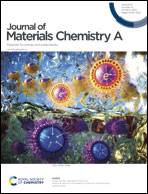Ion-selective aramid nanofiber-based Janus separators fabricated by a dry-wet phase inversion approach for lithium–sulfur batteries†
Abstract
The rapid development of modern portable electronics and electric vehicles toward safety and high reliability puts forward stringent requirements for fast ion conduction, high thermal/mechanical reliability, and easy processing and mass production of electrical insulating separators. Herein, inspired by the Janus separator (JS) with asymmetric properties on each side, we report a large-area asymmetrically structured p-aramid nanofiber (ANF)-based JS (ANF-JS) containing a dense nanoporous layer and a microporous layer, which is fabricated by a facile dry-wet phase inversion approach. The dense nanoporous layer imparts ANF-JS with good ion-selective, exceptionally high ionic conductivity, and insignificant lithium polysulfide (PS) shuttling. The microporous layer with interconnected and three-dimensionally porous structures provides additional channels for significant electrolyte uptake and fast Li-ion transport. Meanwhile, the excellent electrochemical properties are integrated with lightweight (0.7 mg cm−2), good electrochemical stability, nonflammability, a high modulus (up to 690 MPa), and excellent thermal dimensional stability (thermal shrinkage of ∼0% at 200 °C), much better than various conventional separators. Additionally, we successfully demonstrate its continuous and mass production in the form of a thin separator (8–20 μm), achieving outstanding cycle stability with a capacity decay as low as 0.0195% per cycle over 1000 cycles in Li–S batteries.



 Please wait while we load your content...
Please wait while we load your content...